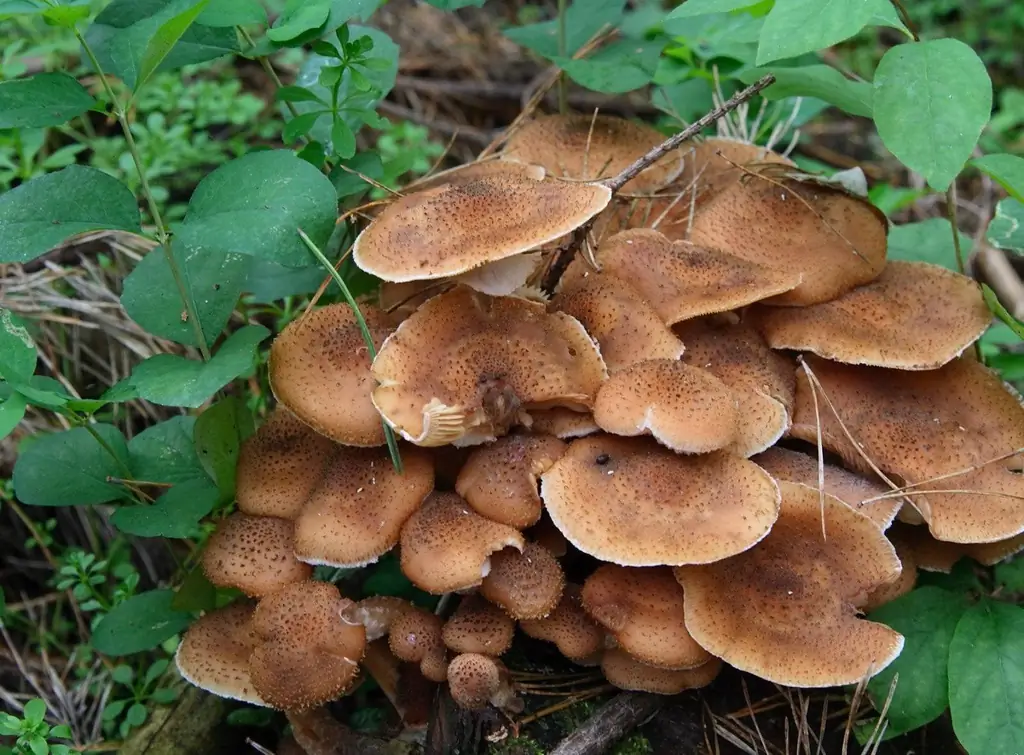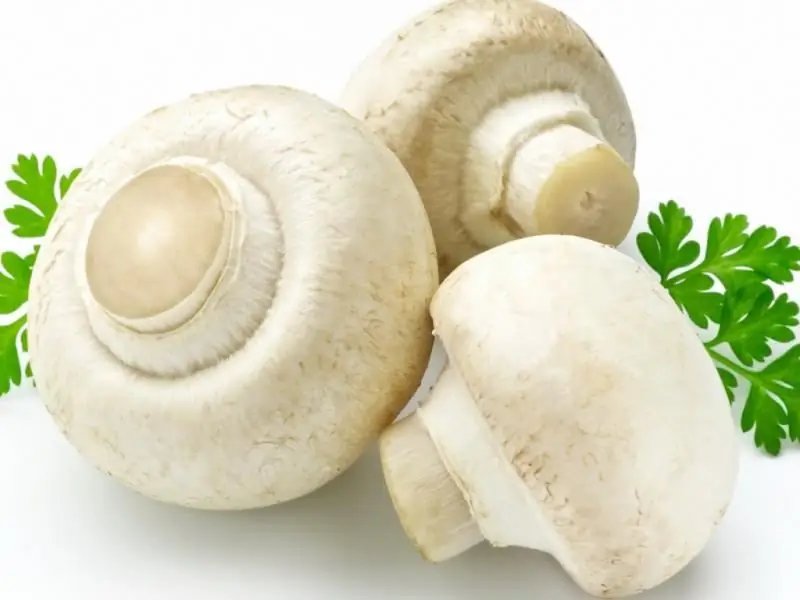
Table of contents:
- Author Bailey Albertson [email protected].
- Public 2023-12-17 12:53.
- Last modified 2025-01-23 12:41.
Honey mushrooms: how to properly clean and wash these mushrooms?

Each mushroom picker rejoices seeing in the forest a clearing of honey agarics, pretty, yellowish, small … Honey mushrooms are very convenient in terms of cooking mushrooms, they can be pickled, salt, and fry, of course, cook soup from them, make mushroom pates … A whole lot of everything ! But before cooking, of course, you need to "put them in order" - be sure to clean and wash so that no foliage or blades of grass, earth and other dirt remain that will obviously not give a pleasant taste to our dishes. Why can sometimes difficulties arise with proper cleaning of honey agarics? They are small in size, that's their whole secret.
Content
- 1 Preliminary cleaning of mushrooms in the forest
-
2 Rules for cleaning mushrooms at home
- 2.1 If mushrooms for drying
- 2.2 For pickling
- 2.3 For freezing
- 2.4 How to properly wash mushrooms
-
2.5 Video: how to properly wash and clean mushrooms?
2.5.1 Is it possible to leave washed mushrooms overnight?
-
2.6 Soaking
2.6.1 In what cases should honey agarics be soaked?
-
2.7 Cleaning honey agarics: step by step instructions
- 2.7.1 Video: how to clean mushrooms correctly and without hassle
- 2.7.2 Are there any differences in cleaning for cooking, frying, marinating?
- 2.7.3 Nuances of cleaning
Preliminary cleaning of mushrooms in the forest
Before you bring the collected mushrooms home and start processing and cooking them, you need to go through the preparatory stage - clean them in the forest, in the same clearing where they were collected. This, of course, increases the time for picking mushrooms, but it's worth it - at home you will not need to do such "dirty work" by spreading newspapers on the floor and placing buckets and basins around the house, there is much more space in the forest for this. So what needs to be done?

Honey mushrooms grow in large families
Carefully sort out the mushrooms, remove badly broken, old or wormy mushrooms from the basket (if the mushroom looks neat from the outside, but it seemed suspicious to us, break the cap in half, check for worms). With a sharp mushroom knife, which we used when we cut off the mushroom legs, we remove the remnants of soil and sand from the mushrooms (usually they are on the lower part of the legs, which can be cut off), as well as adhering leaves, dry pine needles, small twigs and other things we do not need garbage. We cut off the parts of the mushroom legs and caps eaten by insects and be sure to throw them away (some mushroom pickers neglect this, although this is an important step).

It is necessary to remove adhered blades of grass and leaves from the mushrooms' hats
Sometimes the question arises - what to do with a wavy collar on a mushroom leg? It is not necessary to remove it - here you should be guided by your desires, its presence or absence does not affect the taste of ready-made pickled, boiled or fried honey mushrooms.

Under the mushroom hats there is a skirt - a delicate film that can be left or removed
If we were talking about other mushrooms, then it would be necessary to remove the mucous film on the cap, but honey agarics do not have it, so it is much easier to prepare them for home processing.
Rules for cleaning mushrooms at home
It is important to sort the mushrooms as soon as you bring them home, without putting them on the back burner, so the mushrooms, having ceased to receive food from the myceliums, darken very quickly, which does not affect their taste, but the appearance may suffer, which is especially it is important to avoid if we want to salt or pickle them. Fresh mushrooms spoil quickly enough, so we have about five hours to pick them out and pickle, prepare for drying or pickle them.
First, we need to decide what we want to do with our mushrooms, because the way of their further processing depends on this.
To clean mushrooms, we may need a sharp small knife, a dry toothbrush with hard bristles, and a soft brush or piece of soft cloth.

The mushroom knife should be small and sharp
If mushrooms for drying
Honey mushrooms intended for drying should not come into contact with water during cleaning (mushrooms absorb moisture very strongly, and it will not work to dry them qualitatively - the water will not evaporate to the end). In addition to preliminary cleaning of mushrooms in the forest, it is necessary to clean the mushrooms under the cap - use a dry toothbrush to "comb" the plates, there may be bugs or other small insects between them - we remove them with a knife. Remove the remaining sand particles from the caps using a soft cloth or a brush.

If mushrooms are intended for drying, do not soak and rinse them.
For pickling
The mushrooms that we want to pickle must be whole and beautiful, they must be soaked in warm water, 40-50 minutes is enough. The main thing is that soaking lasts no more than an hour, if mushrooms spend too much time in water, they lose their taste. After such soaking, you can remove the skirt (you can not do this, but in brine, the honey agaric skirt usually gets wet, and this affects the appearance of pickled mushrooms), rinse the mushrooms with cool running water, it is important to do this carefully, but not for long. If our mushrooms are very young, we soak them for 10 minutes in slightly salty water, and then rinse them either under running water or in several waters. The washed mushrooms should be boiled in salted water for half an hour, and then salt and pickle.

Before pickling, honey mushrooms need to be washed especially carefully.
For freezing
You need to freeze freshly harvested mushrooms that have not been stored for several days (even in the refrigerator). Only "perfect" specimens are suitable for freezing - whole, without cut off wormholes. In no case should honey mushrooms be washed before freezing, they only need dry cleaning - with a sponge or soft brush we remove dust particles, specks, adhered leaves and twigs. There is no need to cut honey mushrooms into pieces either - they are already small in size.

"Perfect" specimens are suitable for freezing
How to properly wash mushrooms
Honey mushrooms are washed after pre-treatment in a colander, under cool running water. If you want to remove the skirt under the hat from honey agarics, use a stronger pressure.
The most common method - under running water using a colander - is the fastest.

My honey mushrooms in a colander
Video: how to properly wash and clean mushrooms?
Is it possible to leave the washed mushrooms overnight?
You should not risk your health and leave the washed mushrooms overnight. As already mentioned, you need to cook mushrooms as soon as you collect them. However, there is another option - pour boiling water over mushrooms for 10 minutes, put in a colander, rinse with water and put in the refrigerator. The mushrooms are not quite ready and can still be cooked - fried, boiled, pickled. However, they have been heat treated and will definitely not deteriorate.
Soaking
Honey mushrooms are soaked after pre-treatment in the forest and before cutting the lower part of the legs and rinsing the peeled mushrooms with water.
Honey mushrooms are soaked in order to accurately get rid of small worms, which are not visible even with a careful examination of the mushroom. How to soak honey mushrooms correctly? We adhere to the following proportion: for 1 liter of water, we take 1 teaspoon of coarse salt, stir until the salt is completely dissolved and fill the mushrooms with the solution. If our suspicions were confirmed, and there were indeed worms in the mushrooms, they would die and emerge. The maximum soaking time is an hour (if mushrooms are large, you can leave them for 2 hours). If the mushrooms are not very wormy, you can make a less steep salt solution (a quarter teaspoon per 1 liter).

Soaking honey agarics in salt water helps to get rid of small worms
Video: how to soak and clean mushrooms?
In what cases do you need to soak honey mushrooms?
- If we salt honey mushrooms? Be sure to soak them for about two hours in a steep saline solution.
- If we cook honey mushrooms? You don't need to soak them, but focus on cleaning and washing honey agarics.
- If we pickle honey mushrooms? It is not necessary to soak them, but if you wish, you can, reducing the time to thirty minutes. However, it is better to simply pour over them with boiling water, and rinse well before that.
- If we fry honey mushrooms? You can soak, or you can neglect this step.
- If we dry or freeze mushrooms? In no case should you soak them. These cooking methods do not like "wet" mushrooms.
Honey agarics cleaning: step by step instructions
To clean honey agarics, we need a damp sponge, a colander and a small sharp knife. So let's get started!
-
If the mushrooms are clean enough, without excess debris, we wipe them with a damp sponge - both the cap and the legs.

1. Wipe honey mushrooms with a damp sponge After rubbing with a sponge, honey mushrooms become almost clean
-
Cut off the bottom of the leg with a knife if there is dirt on it. If the mushrooms are old, cut the leg closer to the cap, by about 2/3.

Cut off the lower part of the leg of honey agarics Caps and legs can be separated from each other
-
We cut off the damaged areas on the head and leg, if they remain after preliminary cleaning of honey agarics in the forest.

Wormy mushrooms Cut off pieces of honey agarics with wormholes
-
We remove the rim under the cap, if we want it (we can just rinse the mushrooms under a very strong stream of water - the delicate film will simply be washed off).

Skirt under the hat We remove the skirt under the hat from honey agarics
-
We put the mushrooms in a colander and rinse the mushrooms under running water (only if we do not dry them).

We wash honey mushrooms We wash the mushrooms in a colander
- Honey mushrooms are cleaned!
Video: how to clean mushrooms correctly and without hassle
Are there any differences in cleaning for cooking, frying, pickling?
In the preparation of honey agarics, there are no special differences for boiling, pickling or frying. Before cooking or frying, peeled mushrooms are washed in water. Skirts do not need to be removed before frying, since they dry out under the influence of temperature, becoming completely invisible. Before cooking, you can get rid of them if you boil the mushrooms whole and leave them, if you cut the mushrooms into pieces - it's just a matter of appearance. As for the skirts of mushrooms when pickling, they have the unpleasant property of creeping and spoiling the aesthetic appearance of the product - so it is better to remove them.

Before frying honey agarics, you can not remove skirts
Cleaning nuances
Small insects and bugs can be found under the hat between the honey agarics plates, therefore, if the mushrooms are not young, it is worth cleaning them. You can use a small brush and carefully, so as not to damage the plates, walk it from the center to the edges, cleaning out unnecessary living creatures. You do not need to use a brush, but rinse the mushrooms under running water, which will wash away the insects from under the cap, but this will not work for those mushrooms that you are going to freeze or dry.
There is no need to clean fresh young mushrooms that did not come into contact with the ground - they grew on stumps or on the bases of trees, they are already clean.

Young mushrooms need not be cleaned
A damp sponge and a knife are our faithful friends in quick cleaning of honey agarics. If we don't remove the skirt, that also gives us speed.
Cleaning and washing honey mushrooms is not at all a difficult task, but it takes a lot of time if you decide to remove the delicate skirt from under the hat of each honey mushroom. These mushrooms are pleasant to handle and very tasty, the main thing is their proper preparation for salting, pickling, frying or boiling. Using the tips given in the article, you will prepare mushrooms properly. Enjoy cooking!
Recommended:
How To Clean Silver At Home From Blackness Quickly And Efficiently, Than To Properly Clean Silver Jewelry + Photos And Videos

How to quickly clean silver from blackness at home. Effective cleanser recipes. Methods for cleaning products with gilding and stones
How To Properly Clean And Wash Boletus And Boletus, Whether It Is Necessary To Clean The Legs And Caps

How to properly clean boletus and boletus in the forest and at home
How To Clean The Toilet At Home, How To Clean The Cistern And Lid, And Also Wash The Brush

Folk and professional remedies to clean the toilet, practical advice and prevention of various contaminants
Is It Necessary To Clean The Mushrooms Before Cooking, How To Do It Correctly, Is It Necessary To Wash Them

Do I need to clean and wash the mushrooms. Cleaning features for different cooking methods
How To Clean Mushrooms: Redheads, Porcini, Russula, Boletus, Mushrooms, Chanterelles, Oyster Mushrooms And Others

How to properly clean different types of mushrooms: spongy, plate, raincoats. Step-by-step instructions for different mushrooms. Photos and videos on the topic
